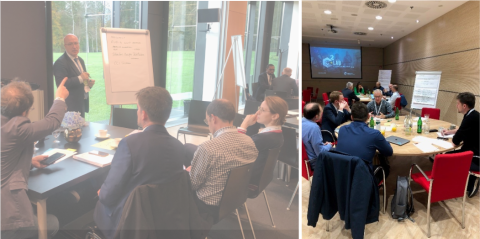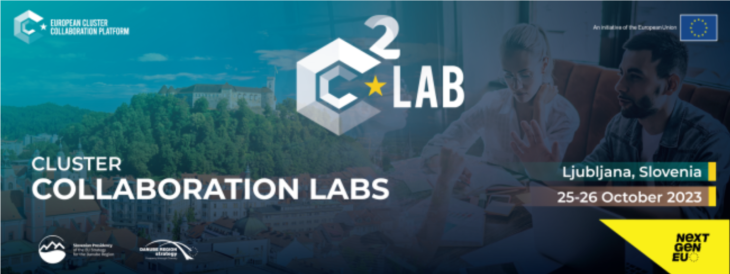C2Lab: Paving the Way for New Projects in the Danube Region
On 25-26 October 2023, the European Cluster Collaboration Platform, supported by the Slovenian Ministry of Foreign and European Affairs, held a Cluster Collaboration Lab (C2Lab) in Ljubljana, Slovenia, to initiate new collaborations and pave the way for projects to support the green and digital transition of the region. It took place next to the EUSDR Annual Forum, which brought together representatives from the European Union to discuss advances in the EU Strategy for the Danube Region, exchange best practices and identify further opportunities for cooperation. The C2Lab welcomed speakers from the region to share their knowledge and insights and offered the chance to find new partners and discuss ideas.
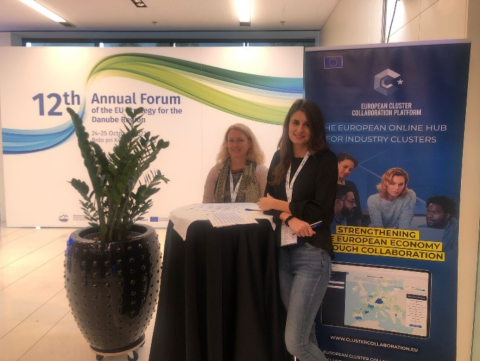
Daniel Acs, President of the Union of Slovak Clusters, and Marek Przeor, Team Leader Cluster Policy from DG GROW, European Commission, warmly welcomed the participants and highlighted how collaboration is needed to drive innovation and access the available funding sources with new ideas. Athanasios Konstandopoulos, Chief Scientific Advisor of CHORUS, set the scene by diving into the challenges and project priorities in the Danube Region. He emphasised the importance of a symbiotic framework within the Danube Region and outlined the 4 pillars and 12 priority areas of the EU Strategy of the Danube Region, looking particularly at Rail-Road-Air Mobility, Sustainable Energy and Culture & Tourism. He threw light on various issues the region faces, from environmental threats to the lack of efficient transport connections and from uneven socio-economic development to improvements that are needed in the research and innovation systems. To establish the projects, he presented the "Resource NEXUS" as an essential framework, focussing on sustainability and resilience. He emphasised the importance of multi-stakeholder collaboration to realize the region's full potential.
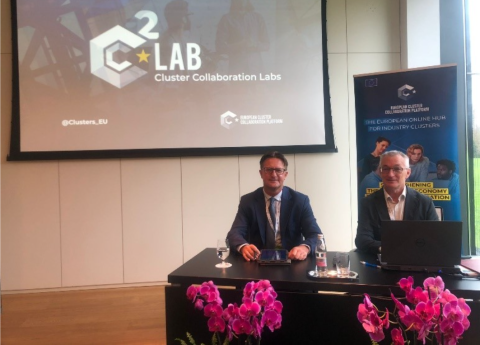
Miljana Cosic introduced the work of the Danube Transfer Centre (DTC) as a good example of how collaboration can be organised. Their primary objective is bridging the divide between research and innovation, ensuring ideas transit from initiation to the market. The Danube Transfer Centre is successful in this endeavour by improving competences and cooperation between producers and users of knowledge. The operational approach is building on sustainable partnerships by exploiting the local and regional innovation potential, capacity building in form of trainings and workshops, the development and implementation of EU projects and the constructive exchange with policymakers and their inclusion in project implementation. She visualised the work on the success story of the DTC Entry Point Iasi. Here, increasing the visibility and introducing new contacts led to new HORIZON projects for the collaboration partners.
Then, the C2Lab offered an overview of the different funding opportunities for the potential projects. Marek Przeor elaborated on the key European priorities of the green and digital transition and building resilience as well as the industrial ecosystem approach. He shared many sources and options to find funding and focused on the programmes that are typically not the “low-hanging fruits” for clusters. Most relevant funds for clusters include Horizon EUROPE, which is the most popular but also most competitive, the Single Market Programme, the LIFE programme and Digital Europe, which is financing the Digital Innovation Hubs. His message is clear: there are many opportunities for clusters and their members, even if they are not specifically mentioned in the call texts.
“We need people to implement to all these funds, to seize the opportunities. We need to bring people together so that they apply”, he underlined. Closing his presentation, Marek Przeor explained the usual steps in the programme’s implementation and gave some practical advice on how to apply, encouraging cluster managers to regularly check the calls for proposals. “This is one of the key activities of cluster managers.”
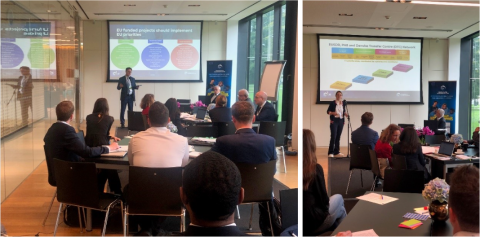
Another funding opportunity for projects is the Seed Money Facility (SMF) of the Danube Region Programme, which was presented by Carmen Hawkins from the Ministry of Economic Affairs, Labour and Tourism Baden-Württemberg and Helia Kovačević Grčić from the Croatian Ministry for Economy and Sustainable Development. The aim of the SMF is to initiate the development of strategic projects and large-scale initiatives for the EUSDR. Private entities like cluster organisations and companies can be beneficiaries of this programme. It finances projects that include participants from at least two Danube Region Programme countries. The programme has now extended its umbrella to also encompass the entire territory of Ukraine. A significant emphasis is placed on projects that can make direct or indirect positive contributions to sustainable development, particularly focusing on environmental and climate objectives. Financially, the programme is set to offer substantial support, with co-financing rates reaching up to 80% of a project's total budget. For those keen to apply, they should mark their calendars, as the call will open at the end of November 2023.
How can a successful project application look like? Niko Natek from the Energy Agency of Savinjska, Šaleška and Koroška (KSSENA) showcased a successful project application to I3, the Interregional Innovation Investments Instrument. He underscored the pressing challenges facing the European Union, particularly in the energy sector. With our modern society's dependence on affordable resources and given the current global conflicts, it’s evident that a significant shift is needed in the energy-intensive industries. The I3 cohesion policy, as described by Natek, emerges as a transformative tool in the EU's toolkit. Rather than just providing funds, it reimagines the structure of funding by focusing on interregional cooperation, tangible innovation from ideation to commercialisation and, most notably, direct investments to fuel innovative endeavours. Their project, Green Transition in Central Europe, engages companies across specific domains like sustainable energy, eco-construction, regenerative farming and renewable gases. He highlighted that the successful application is based on the project relevance (targeted and tailor-made measures for relevant target groups), the partner consortium capacity and references (relevant to their long-term ambitions), the wide stakeholder outreach (e.g., large network of associated partners) and the ambitious scope of intervention (number of S3 Partnerships in which regions are actively participating, number of companies involved, number of engaged intermediaries, etc.).
After these inspiring inputs that provided the context and informed on funding opportunities, Athanasios Konstandopoulos spoke about the methodology for project creation, emphasising the significance of talent, culture and capital. He discussed the transition and evolution of organizations and the impact on their value generation methods. In addition, we need to keep in mind the notable trend observed in today's dynamic landscape, which is the reversal of globalisation. With the global scene shifting, there is an increasing emphasis on bolstering local capacities and resources. He underlined that creating synergies functions across various domains, including entrepreneurship, innovation, research and education. Successful project creation requires a holistic approach, taking cues from global challenges, insights from business development, customers and relevant literature. It is imperative to integrate skilled individuals into the process, determine the technology building blocks, processes and platforms, and putting this roadmap into operation. Central to this is understanding the underlying concepts that bind people, ensuring they play their roles effectively, maximise resources and cultivate meaningful relationships.
After this input, the exchanges between the participants and the identification of project ideas began. The participants presented their entities and interest and gathered in smaller working groups. In these groups, they spoke about their competences and areas of activities as well as the interests and ideas that could be created if they partnered up. These discussions started in afternoon of 25 October and continued during 26 October. The discussions of the project ideas centred around sustainable plastics, recycling and returning waste into the life cycle, skills and education and construction.
After this C2Lab, the participants will follow up on their ideas and exchanges to continue with their development and turning them into project proposals.
